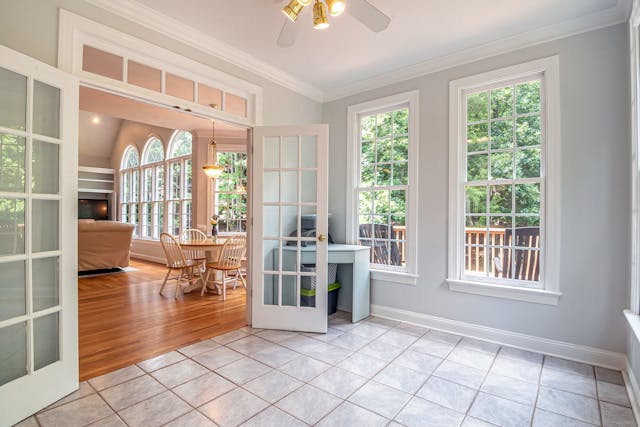
Doors are more than just entryways—they set the tone for your home’s curb appeal, provide security, and play a role in energy efficiency. If you’re deciding between a storm door and a regular door, understanding the key differences can help you choose the best option for your needs.
Some homeowners assume storm doors are unnecessary, while others swear by them for added protection. So, what’s the real difference? And do you need both?
What Is a Storm Door?
A storm door is a second door installed in front of an exterior door. It acts as a protective barrier, shielding the main door from the elements while allowing ventilation and natural light into the home. Typically, storm doors have glass panels, sometimes with screens that can be swapped out depending on the season.
The primary purpose of a storm door is to provide extra insulation, security, and protection against harsh weather conditions. They are especially popular in areas with extreme temperatures, whether hot or cold, because they add an extra layer of insulation to keep indoor temperatures stable.
Common Features of Storm Doors
- Glass or screen panels – Many models come with interchangeable glass and screen inserts to adjust for seasonal changes.
- Weather-resistant materials – Typically made from aluminum, vinyl, or wood with a durable outer layer.
- Insulation benefits – Helps reduce drafts and improve energy efficiency.
- Security enhancements – Some models come with reinforced locks and metal frames to deter break-ins.
What Is a Regular Door?
A regular door, or an entry door, is the main exterior door of a home. It serves as the primary barrier between the inside and outside world, offering security, privacy, and insulation. Unlike storm doors, regular doors are typically solid and designed to withstand direct exposure to weather conditions.
Common Features of Regular Doors
- Various materials – Can be made of wood, fiberglass, steel, or composite materials, each with different levels of durability and insulation.
- Weatherproofing options – Often includes built-in weatherstripping and insulation to help with energy efficiency.
- Decorative appeal – Comes in a variety of styles, colors, and finishes to match a home’s aesthetic.
- Security-focused – Typically designed with strong locks and reinforced frames to prevent forced entry.
How Do Storm Doors and Regular Doors Compare?
Now that you know what each type of door is, let’s look at how they stack up in different areas.
1. Protection from the Elements
Regular doors are built to withstand exposure to rain, wind, and extreme temperatures, but they can still take a beating over time. Sun exposure can cause fading, moisture can lead to warping, and heavy storms can wear down materials.
One of the main benefits of storm doors is the level of protection they provide. A storm door acts as a buffer, preventing direct exposure to harsh weather. This can extend the life of your main door by reducing its exposure to rain, snow, and UV rays. If you live in an area with frequent storms, high winds, or extreme temperatures, a storm door can help preserve your regular door’s condition.
2. Energy Efficiency
Energy efficiency is a major factor for homeowners looking to cut down on heating and cooling costs. Regular doors provide insulation, but some materials (like wood) may not be as effective at preventing heat loss or gain.
Storm doors add an extra layer of insulation, reducing drafts and preventing outside air from creeping into the home. In winter, they help keep warm air inside, while in summer, they allow ventilation without letting in bugs when used with a screen insert.
If energy efficiency is a priority, a storm door could be a worthwhile investment, especially if your regular door isn’t well-insulated.
3. Ventilation and Natural Light
A solid entry door limits how much natural light enters your home. If you want to let in sunlight without opening the door entirely, a storm door with a glass panel can be a great solution.
Additionally, storm doors with retractable screens allow for ventilation. This is ideal in spring and fall when you want fresh air without fully exposing your home to outdoor elements. Regular doors don’t provide this flexibility unless they have built-in glass panels or sidelights.
4. Security Considerations
Regular doors are designed with security in mind, often featuring reinforced materials and high-quality locks. Some even come with smart locks or additional security features.
Storm doors can add an extra layer of security, especially if they have a strong frame and a secure locking mechanism. A storm door provides a secondary barrier that can make it more difficult for intruders to access the main door. However, not all storm doors are built with security in mind, so it’s important to choose a reinforced model if this is a concern.
5. Cost and Installation
Regular doors can range widely in price depending on material and design. A high-quality entry door made of solid wood or reinforced steel can be a significant investment.
Storm doors, on the other hand, are generally more affordable. While they do come at an additional cost, they can save money in the long run by extending the life of your main door and improving energy efficiency.
Installation is another factor to consider. If your home has an irregularly sized doorway, custom options may be necessary, increasing the cost for both types of doors.
Do You Need a Storm Door?
Not every home requires a storm door. If your entry door is already well-insulated and protected, adding a storm door might not be necessary. However, in certain situations, a storm door is a smart addition:
- You live in a harsh climate – Homes in areas with extreme cold, heat, or frequent storms benefit from the added protection.
- Your main door lacks insulation – If your current door lets in drafts, a storm door can improve energy efficiency.
- You want ventilation without bugs – Retractable screen models allow fresh air in without inviting pests.
- You want to preserve your main door – A storm door can prevent fading, warping, and general wear and tear.
On the other hand, if you have a well-insulated, durable entry door in a mild climate, a storm door might not be necessary. Some homeowners also find storm doors inconvenient if they use their main door frequently, as it adds an extra step to entering and exiting the home.
Making the Right Choice
Both storm doors and regular doors serve important functions, but their value depends on your home’s specific needs. If protection, energy efficiency, and ventilation are top priorities, a storm door can be a great addition. If you already have a high-quality, insulated entry door, it may not be worth the extra cost.
Ultimately, the decision comes down to climate, security needs, and how much you want to extend the lifespan of your main door. Understanding these factors can help you make the best choice for your home—one that keeps you comfortable and secure year-round.




